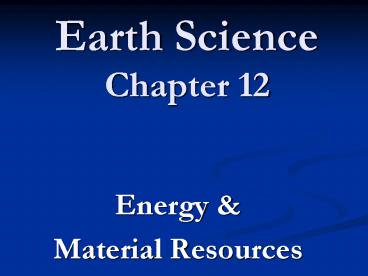Earth Science Chapter 12 - PowerPoint PPT Presentation
Title:
Earth Science Chapter 12
Description:
Earth Science Chapter 12 Energy & Material Resources Energy & Fossil Fuels A fuel is a substance that provides a form of energy such as heat, light, electricity, or ... – PowerPoint PPT presentation
Number of Views:109
Avg rating:3.0/5.0
Title: Earth Science Chapter 12
1
Earth ScienceChapter 12
- Energy
- Material Resources
2
Energy Fossil Fuels
- A fuel is a substance that provides a form of
energysuch as heat, light, electricity, or
motion - energy-rich substances formed from the remains of
once-living organisms. - The three major fossil fuels are coal, oil, and
natural gas. They are considered nonrenewable
resources. - Hydrocarbons - energy-rich chemical compounds
that contain carbon and hydrogen
3
Different Forms of Energy
- 6 different types
- Mechanical
- Thermal Energy
- Chemical Energy
- Electrical Energy
- Electromagnetic Energy
- Nuclear Energy
4
Energy Conversion and Conservation
- Most forms of energy can be converted from one
type to another. - Law of the Conservation of Energy - states that
energy cannot be created or destroyed. It simply
changes from one form into another - Einsteins theory of Relativity - E mc2
- a small amount of mass can be changed directly
into a tremendous amount of energy - E the energy produced
- m the mass being converted
- c the speed of light (186,000 miles/second)
5
Fossil Fuels - Coal
- Solid fossil fuel formed from decaying plant
matter. - Coal is the most plentiful fossil fuel in the
United States
A Sedimentary Rock obtained through Underground
mining or open pit mining
6
Fossil Fuels - Oil
- Oil (Petroleum) is a thick, black liquid fossil
fuel. - Oil is formed from the remains of small
ocean-living organisms. - Crude oil is separated into fuels and other
products by heating is
called a refinery - Petrochemicals are compounds that are made from
oil.
7
Fossil Fuels - Natural Gas
- Natural gas is 95 Methane, (CH4) other gases.
- Natural gas forms from the same organisms as oil.
- Because it is less dense than oil, natural gas
often rises above an oil deposit, forming a
pocket. - Natural gas produces lower levels of many air
pollutants than coal or oil and is fairly easy to
transport.
Gas is typically under great pressure, as water
is pumped out, the pocket pressure is reduced
the gas comes out of solution, bubbles up out
to be recovered.
8
Renewable Sources of Energy
- Include Solar, wind, biomass, geothermal tides
- Hydroelectric Power - Once the dam and power
plant are built, hydroelectric power is
inexpensive and clean. Dams can have negative
effects on the environment. - Wind power - Large wind farms contain many wind
turbines. The turbines turn to generate
electricity. Wind power causes no pollution and
is renewable. It is possibly the fastest-growing
energy resource. Drawbacks of using wind power
include the need for steady strong winds and
opposition to the building of wind farms in
scenic areas.
9
Renewable Sources of Energy
- Biomass Fuels -Fuels made from material that was
once part of a living thing - Energy from Tides harnesses the regular rise
fall of the oceanic tides, Tidal power plants use
this regular flow to turn turbines and generate
electricity.
10
Nuclear Energy
- Nuclear fission the splitting of an atom's
nucleus into two smaller nuclei - In a nuclear power plant, the heat energy
released from fission is used to change water
into steam. The steam then turns the blades of a
turbine to generate electricity. - The reactor contains rods of uranium, called fuel
rods. The chain reaction is controlled by placing
control rods made of the metal cadmium between
the fuel rods. The heat that is produced is used
to boil water to produce steam, which runs the
electrical generator. - Major environmental disasters can occur when
meltdowns occur - Nuclear fusion is the combining of two atomic
nuclei to produce a single larger nucleus - In nuclear fusion, two hydrogen nuclei combine to
create a helium nucleus, which has slightly less
mass than the two hydrogen nuclei. The lost mass
is converted to large amounts of energy. - Nuclear fusion is a promising future energy
source.
11
Nuclear Energy - Fission
12
Nuclear Energy - Fusion
13
Energy Conservation
- One way to preserve energy resources is to
increase the efficiency of energy use. - Another way is to conserve energy whenever
possible. - Recycling Material Resources - Three methods of
handling solid waste are burning, burying, and
recycling. - What can individuals do?
- These are sometimes called the "three R's
- reduce, reuse recycle
- Reduce refers to creating less waste in the first
place. - Reuse refers to finding another use for an object
rather than discarding it. - Recycle refers to reclaiming raw materials to
create new products.

